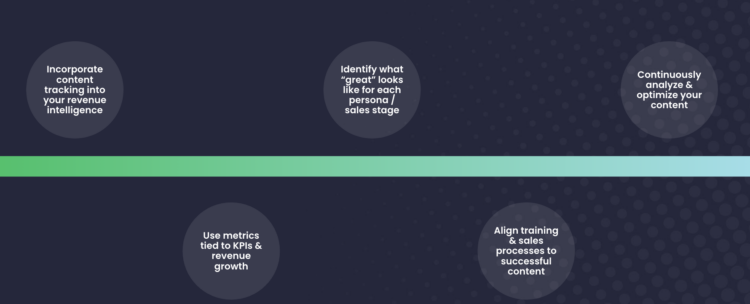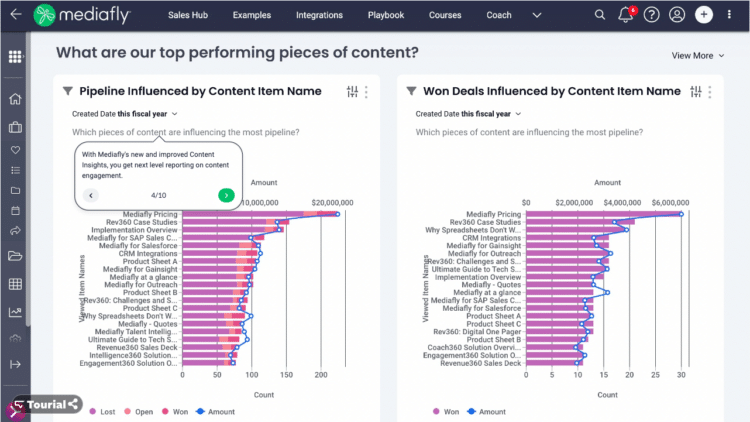As buyers increasingly choose to interact with sellers digitally it’s no secret they’re leaving treasure troves of data behind. Every sales leader is scrambling to collect as much of that data as they can to provide their teams with the best sales analytics and insights to be as effective as possible. Markets and Markets estimates that the sales intelligence market size will grow from $2.4 billion in 2019 to $3.4 billion in 2024. It’s a big deal.
Gartner defines Revenue Intelligence tools as, “solutions that enhance the activity management, deal insights and pipeline analytics offered by sales force automation (SFA) platforms. Revenue intelligence platforms facilitate the capture of sales interactions and coach sellers to quickly anticipate buyers’ needs”. However, the same report fails to count the content reps send to buyers as an interaction. Content engagement analytics are a massive indicator of deal health, key to optimizing content, and should be collected to inform revenue intelligence.
The importance of tracking content engagement
There are myriad metrics that organizations use to collect and drive their revenue intelligence efforts, including:
- Site visits and interactions
- Buyer intent
- Content engagement
- Email opens & clicks
- Phone calls, answer rates, messages, callbacks
- Conversation intelligence, including keyword usage, overtalk, interruptions, conversation length, and so on
- Deal progression
- Adherence to sales playbook
- Highest selling products
- Close rate & velocity
- Product usage among existing customers
While some are familiar to most sales leaders, others are metrics that once were invisible, now offer a sizable opportunity to impact and inform their revenue strategies. The purpose of this blog is to talk about the importance of one set of metrics in particular – content engagement.
Today only 5%of a buyer’s time is spent with a vendor, and 55% of buyers are in a state of information overload just from the information they get from sellers. During the 95% of time that buyers spend away from you, you still must break through the information overload to stand out from the sea of content buyers are constantly bombarded with. You need to influence buyers’ decision making during that 95%. Content is the only way. With proper content engagement analytics and insights, you can optimize and tailor your content so it’s working for you when you’re not in the room.
The metrics to track
Every organization has internal content and external content, content for specific roles, content for specific industries and/or company sizes, specific content for each sales stage. It’s not a one-size fits all. In order to create the content possible you need to be tracking the success of each piece of content with each persona, in each industry, at each moment in the sales cycle it’s used. Here are the top 10 content engagement metrics you should be tracking:
- Content Views
- Content Shares
- Does content impact win rates?
- What content influences pipeline?
- Are we using content at the right time in the sales process?
- Internal vs external impact
- What types of content perform the best?
- Is content being downloaded and used offline?
- Are we keeping up with stale and outdated content?
- Is our content strategy scalable?
What to do with your content engagement analytics?
In order to chart an intentional course forward – for anything – you first need to understand what exists today and identify where your gaps are. Semrush recently found 44% of marketers and business owners said improving the quality & value of their content has led to increased success. That’s easier said than done. It starts with a content audit. Fifty-three percent of marketers and business owners said they saw improvements in content engagement rates after a content audit. Once you have an inventory of the content you have, use the analytics to measure their success and then:
- Identify what works, when it works, and who it works with. Again, this is not a one-size fits all. Each persona in each industry has their own “Cinderella slipper” of content, and your goal should be to identify each one based on engagement analytics and what moves deals forward. It’s going to take some discovery. Identify pain points and A/B test content to see what works, when, and with whom.
- Personalize content to each industry and each role. Once you understand what works with each audience, personalize each piece of content to what you know works for them. Today’s buyers demand the level of personalization they get from B2C companies in their everyday lives. McKinsey found that 77% of companies using direct one-to-one personalization observed an increase in market share.
- Align internal sales processes to content you know works. In privacy there is a concept of “privacy by design” – which means that privacy is best adhered to when it is integrated into technology when it’s first created. The same principle should be applied with your sales content. Once you know what works, when and with whom, bake that into your internal sales processes and training. “You should send the Acme case study to VPs of Sales Enablement at CPG companies at this specific point in the sales cycle.”
- Ensure content is easily accessible and shareable with the right tagging. Don’t make your sellers spend time finding the awesome content you’re making! Despite the amount of content available to sellers, up to 70% of marketing produced content goes unused. This is in part because 65% of sales reps can’t locate meaningful content to share with buyers – making it the most common complaint among US sales teams. Ensure your sellers can find the great content you’ve made – using precise tagging and keywords – so they can share it when they need to.
- Never stop improving! This is not a set it and forget exercise. In order to keep up with buyer demands and the pain points of your audiences, you need to continuously track the engagement and success of your content. It will not only lead to better content, but it will help inform deal health and forecasting so your organization can make more informed decisions that lead to more closed deals.

Content engagement metrics simply aren’t enough anymore. The number of shares, clicks, and opens don’t correlate to closed won. There are deeper, better insights you need to optimize content strategy. You must be able to connect individual pieces of content – when, how and with who they are used – to win rates. At Mediafly, we’ve made this a priority.. We’re extremely proud to launch a new offering: Enhanced Content Insights. With Mediafly’s new and improved Enhanced Content Insights, you can connect sales content to cold, hard cash. With this new offering you’ll know what content works, with who, when – so you can do it again, and again, and again.To learn more about our new Enhanced Content Insights offering, take our product demo below!


Comments are closed.